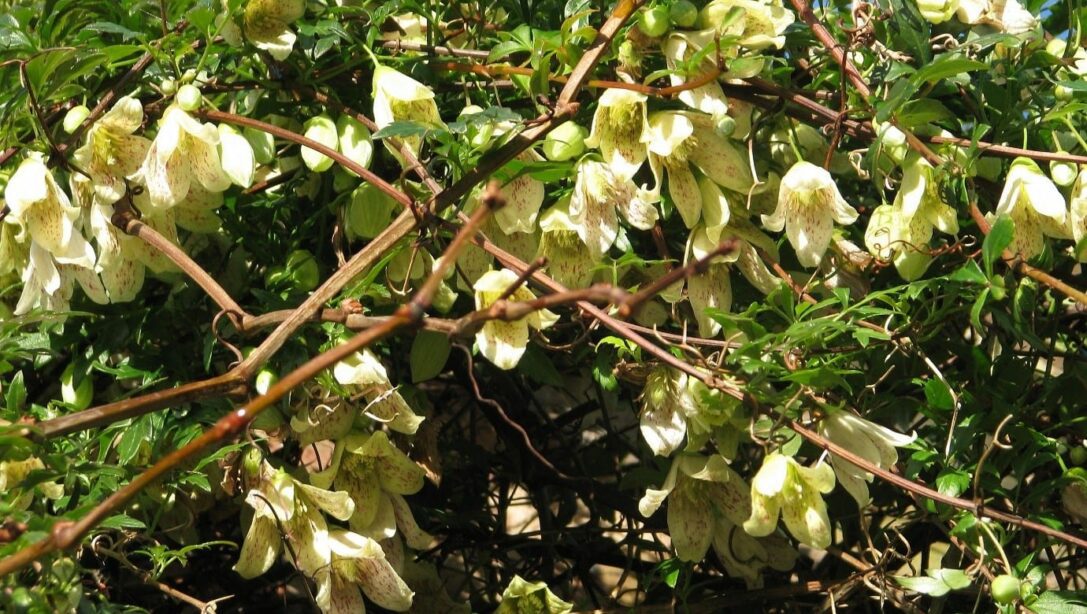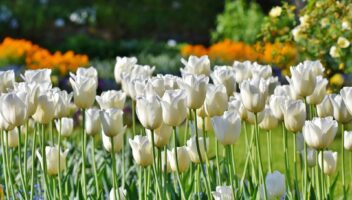Evergreen climbing plants are extremely valuable in gardens of every size. They can bring interest to plain walls and fences, hide unsightly spots and by nature of growing upwards, allow you to extend the area of your garden that can be covered in foliage and flowers.
Climbing plants can either be evergreen or deciduous. If your climbing plant is being used to screen something or to create year-round interest, evergreen climbers are particularly useful as they keep their leaves (or most of them) all year-round.
We share some of our favourite varieties of evergreen climbing plants, along with tips for how to grow climbing plants in your garden.
Evergreen Climbing Plant Recommended Varieties
Trachelospermum jasminoides | Star Jasmine

Trachelospermum jasminoides, commonly known as star jasmine, is an evergreen climber that offers the dual benefit of beautiful, white fragrant flowers during summer. While it is evergreen in the true sense of the word, the glossy green leaves will turn a scarlet red over winter. It is a reasonably fuss-free plant, and will happily cling to supports without needing additional help – although young growth may benefit from being tied in. At maturity, it can grow up to 9 metres in height by 5 metres in spread.
Position it in a sunny, sheltered spot in the garden in free-draining soil – south or south-west facing is ideal. To get the best of its delightful scent, try growing it near a seating area or close to your door.
Lonicera japonica ‘Halliana’ | Japanese Honeysuckle

Image: Wikimedia Commons, Wouter Hagens.
This vigorous variety of Japanese honeysuckle is strictly speaking a semi-evergreen, as it may lose some of its glossy green leaves in winter – particularly in colder climates. New foliage will appear again in the spring in this case.
This is a fast-growing climber, that will stretch to 10 metres high by 2 metres wide, making it perfect when you have a wish to quickly cover something in the garden. From mid-spring all through summer, it produces fantastically scented white flowers, which will eventually yellow in time.
Position in sun or partial shade in any moist, well-drained soil and enjoy the sight of it quickly making its way over your fence, wall or arches. It will also intertwine up trees or large shrubs.
Lonicera japonica ‘Horwood Gem’ | Japanese Honeysuckle
Lonicera japonica ‘Horwood Gem’ is another fantastic Japanese honeysuckle variety. Again, it is strictly speaking a semi-evergreen, as it may lose some of its glossy green leaves in winter.
Another vigorous grower, this climber will eventually reach up to 6 metres in height. This variety offers unusual variegated foliage and the beautiful honeysuckle scent from its large yellow and white flowers.
Position in sun or partial shade in any moist, well-drained soil and enjoy the sight of it quickly making its way over your fence, wall or arches. It will also intertwine up trees or large shrubs.
Lonicera henryi ‘Copper Beauty’ | Henry’s Honeysuckle
Lonicera henryi ‘Copper Beauty’ is a striking variety that produces yellow flowers from early summer, that take on a red flush. Strictly a semi-evergreen, as it may lose some of its leaves over winter, the new spring foliage is an unusual bronze colour, turning green over time.
This fast-growing climber will reach anywhere between 4 – 8 metres at maturity. Position in sun or partial shade in any moist, well-drained soil and enjoy the sight of it quickly making its way over your fence, wall or arches. It will also intertwine up trees or large shrubs.
Clematis cirrhosa
Clematis cirrhosa varieties are evergreen, winter-flowering clematis – very useful for keeping interest in the garden in every season. Plants offer deep green leaves and pale creamy-yellow flowers, often with speckled markings, from late winter into early spring. These blooms nod downwards, a little like hanging bells.

A moderate size climber, plants reach up to around 3m tall. Position in a sunny, sheltered spot in any fertile, well-drained soil. This is a particularly good choice if you have dry soil – so much so the plant will happily grow under and up through a conifer hedge.
Clematis ‘Early Sensation’

Clematis ‘Early Sensation’ is another relatively moderate size evergreen clematis, reaching up to 3 metres in height.
The masses of flowers produced from mid to late spring are delightful; white with a lime green centre and fragrant. After these, you can enjoy the sight of the fluffy seed-heads for continued interest. The foliage starts a bronze-brown colour, then matures to a deep green.
Position in full sun to partial shade. This will need a little help and support, so tie it in as it grows or train it around an archway or obelisk.
Clematis armandii

This fast-growing evergreen clematis variety offers long, glossy lance-shaped green leaves all year round and a mass of sweetly scented creamy-white flowers throughout spring. The flowers are a pretty star shape, bringing great interest to the early spring garden.
Position in a sheltered, sunny spot in any moist, well-drained soil and over time it can reach up to 5 metres in height. While the plant enjoys the sun, the roots enjoy the cool – so plant deeply, or mulch well around the base of the plant. This variety of clematis does not necessarily require pruning, but you can prune after flowering to maintain the desired shape and it is hardy throughout most of the UK.
Top Tips for Growing Climbers
- Climbing plants can live for a long time, so it’s essential to give them a good start in life. Water your plant thoroughly in its pot before transferring to its planting position – whether that’s in the ground, or in a container
- If growing against a wall, ideally position the hole for your plant at least 45cm away (in some instances, this won’t be possible where space is limited, in which case go for the maximum distance possible within your space)
- Incorporate plenty of quality growing material, like a good peat-free compost, into either the container of the ground when planting
- Many climbers will need some support as they grow. If the stems are not initially long enough to reach the wall or support, use angled bamboo canes and tie them in. Options for supports can be many and varied. For fences and walls, you could create a framework of wire stretched between vine eyes. Allow around 45cm between each horizontal row. You may also choose to hang a trellis for your climber to grow up, or, you may be growing over an arbour where you will naturally be able to tie the plant in as it grows
- Climbers generally don’t damage walls so long as the wall is already in good condition. If anything, they offer protection from the weather





